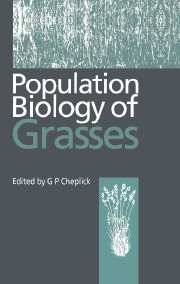Book contents
- Frontmatter
- Contents
- Contributors
- Preface
- Darwin revisited: approaches to the ecological study of grasses
- Part one Population variation and life history patterns
- Part two Ecological interactions
- 8 Plant–plant interactions in grasses and grasslands
- 9 Competition between grasses and woody plants
- 10 Fungal endophyte infection and the population dynamics of grasses
- 11 Arbuscular mycorrhizas and the population biology of grasses
- Part three Population biology of specific groups
- Index
8 - Plant–plant interactions in grasses and grasslands
Published online by Cambridge University Press: 14 September 2009
- Frontmatter
- Contents
- Contributors
- Preface
- Darwin revisited: approaches to the ecological study of grasses
- Part one Population variation and life history patterns
- Part two Ecological interactions
- 8 Plant–plant interactions in grasses and grasslands
- 9 Competition between grasses and woody plants
- 10 Fungal endophyte infection and the population dynamics of grasses
- 11 Arbuscular mycorrhizas and the population biology of grasses
- Part three Population biology of specific groups
- Index
Summary
Plants do not experience average population densities or overall levels of resource supply. Spatial structure of plant populations and communities is an important consequence of the sessile nature of plants and of the discrete quality of individual organisms (Silvertown & Lovett Doust, 1993; Tilman, 1994). Close neighbours exploit the same resources, endure the same macro- and microenvironmental controls, and interact more or less independently with herbivores, pathogens and mutualistic organisms. Although plant–plant interactions are affected by all these factors, in this chapter we will focus on direct effects between neighbours and individual interactions mediated by resource exploitation. The remaining influences are covered elsewhere in this volume (see Chapters 9, 10 and 11).
The reciprocal effects between plants and their local environment are modulated by their life cycle. Establishment, resource acquisition, growth, recruitment, and death all affect and are affected by attributes of the local environment or neighbourhood. These continuous interactions among plants and their local environment are experienced by close neighbours over a range of temporal scales. The results of these interactions ramify upwards through the system to affect population, community, and ecosystem level properties.
In our analysis of plant–plant interactions, we will first deal with the spatial pattern of individuals, focusing on neighbourhood characteristics and their significance for individual performance and the recruitment of new individuals. We will then turn our attention to competitive ability. Here we will discuss both the effects of grasses on resource availability as well as the response of grasses to resource availability. We will end with an evaluation of the significance of plant-plant interactions for community and ecosystem processes.
- Type
- Chapter
- Information
- Population Biology of Grasses , pp. 209 - 230Publisher: Cambridge University PressPrint publication year: 1998
- 9
- Cited by



